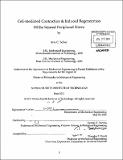Cell-mediated contraction & induced regeneration of the injured peripheral nerve
Author(s)
Soller, Eric C
DownloadFull printable version (23.07Mb)
Alternative title
Cell-mediated contraction and induced regeneration of the injured peripheral nerve
Other Contributors
Massachusetts Institute of Technology. Dept. of Mechanical Engineering.
Advisor
Ioannis V. Yannas.
Terms of use
Metadata
Show full item recordAbstract
Cell-mediated mechanical forces drive closure of severe wounds in adult mammalian organs, including the sciatic nerve following neurotmesis. Without experimental intervention the defect closes rapidly via contraction of transected nerve stumps by a thick, cohesive capsule of myofibroblasts (MFB) and subsequent collagen synthesis (scar), leading to a painful neuroma. Despite considerable progress in regenerating injured peripheral nerves with biomaterials, adequate recovery is generally limited to inter-stump gap lengths of about 20-30 mm in humans. Observations of successful induced regeneration in adults coincide with reduced MFB formation, yet the direct effect of the MFB capsule on nerve regeneration is unknown. According to the pressure cuff theory, a transected peripheral nerve could heal by regeneration, rather than MFB-mediated contraction and scar formation, provided the MFB capsule size (and corresponding cellular forces applied) are reduced. A well-characterized library of type I collagen tubular scaffolds with identical chemical composition and pore size, and varying degradation rate was used to evaluate the ability of a porous scaffold to block MFB contraction after injury in a demanding model of peripheral nerve regeneration in the adult rat. At 9 weeks post-neurotmesis, the MFB capsule thickness, 5, around the regenerating nerve was measured and the correlation with several quantitative measures of the quality of nerve regeneration, Q, was evaluated. A negative, statistically significant association was observed between the contractile capsule thickness, 6, and the quality of axonal regeneration, Q, (consisting of measures of regenerate area, the number of myelinated fibers, and the number of largediameter fibers) at 9 weeks post-sciatic neurotmesis. This constitutes the strongest evidence to date that capsules of contractile MFB antagonize induced regeneration of severely injured peripheral nerves in the adult mammal. Collagen devices of intermediate degradation rate minimized 5 and maximized Q. Reduced contractile cell presence and disrupted organization inside moderately cross-linked scaffolds that consequently degraded at an intermediate rate, but not in highly cross-linked scaffolds that degraded at very low rate, support the hypothesis of cell escape from the wound (making use of scaffold permeability) as a mechanism for scaffold regenerative activity.
Description
Thesis (Ph. D.)--Massachusetts Institute of Technology, Dept. of Mechanical Engineering, 2011. Cataloged from PDF version of thesis. Includes bibliographical references.
Date issued
2011Department
Massachusetts Institute of Technology. Department of Mechanical EngineeringPublisher
Massachusetts Institute of Technology
Keywords
Mechanical Engineering.